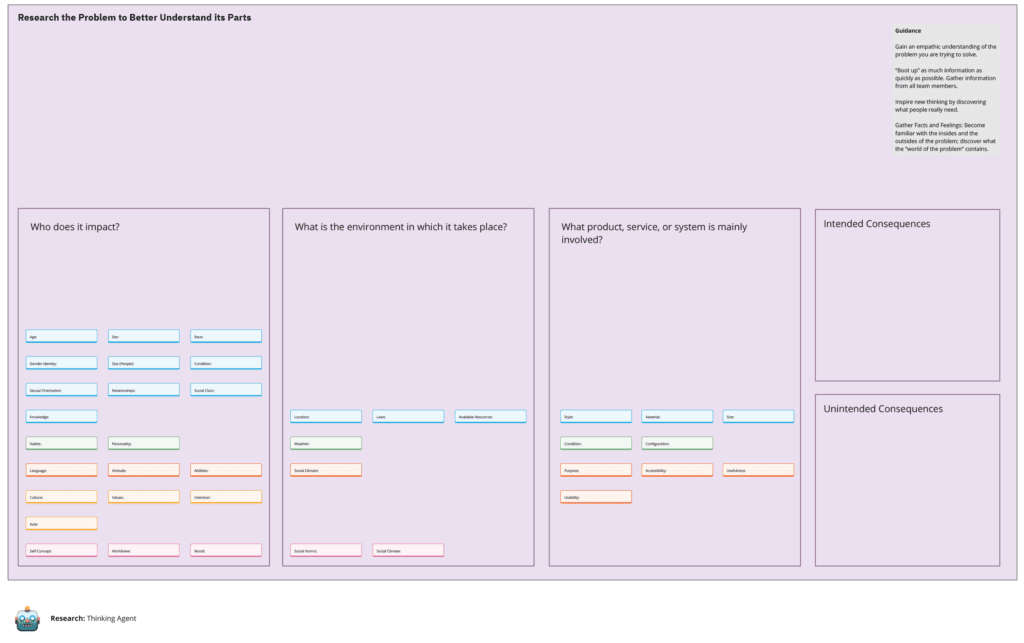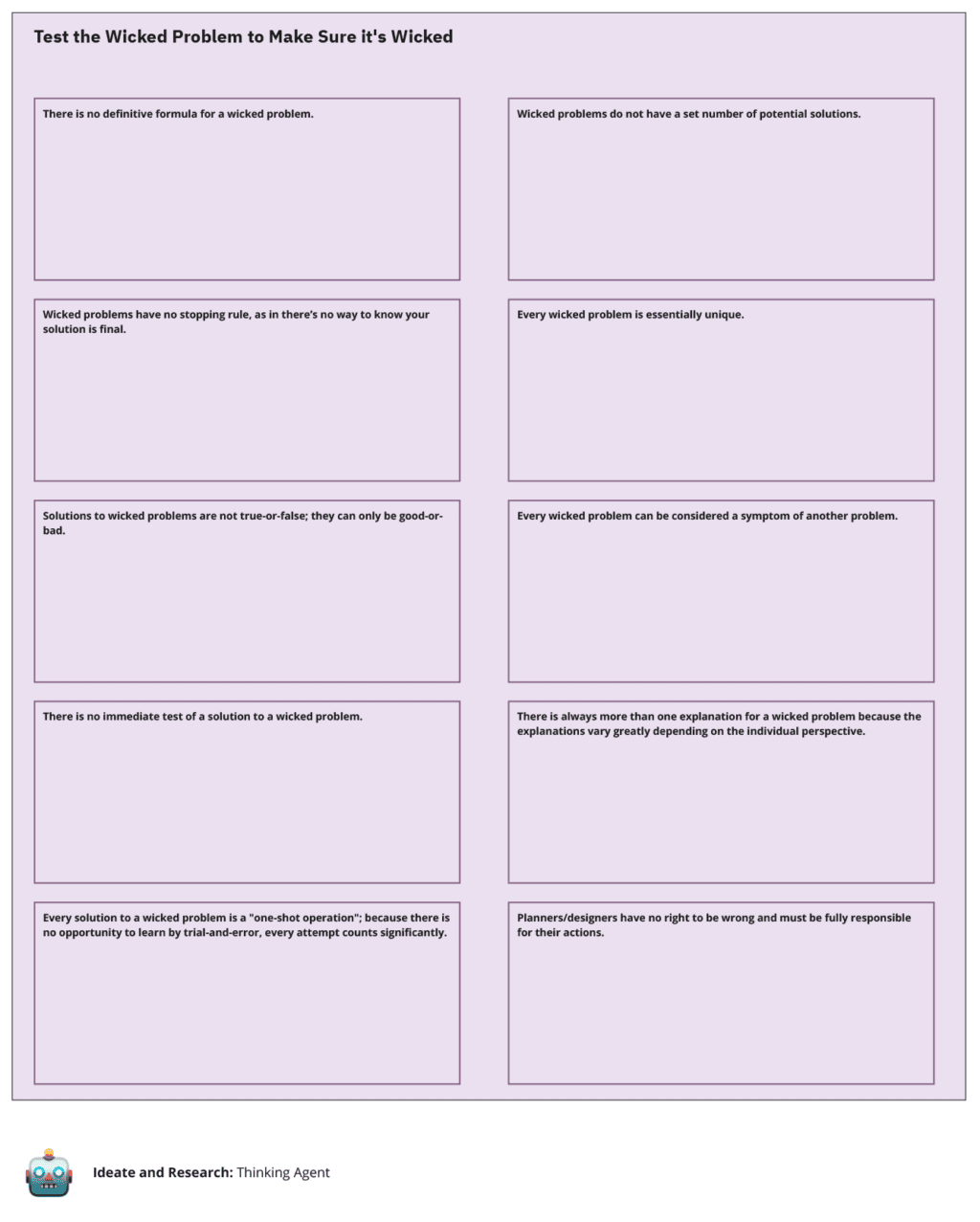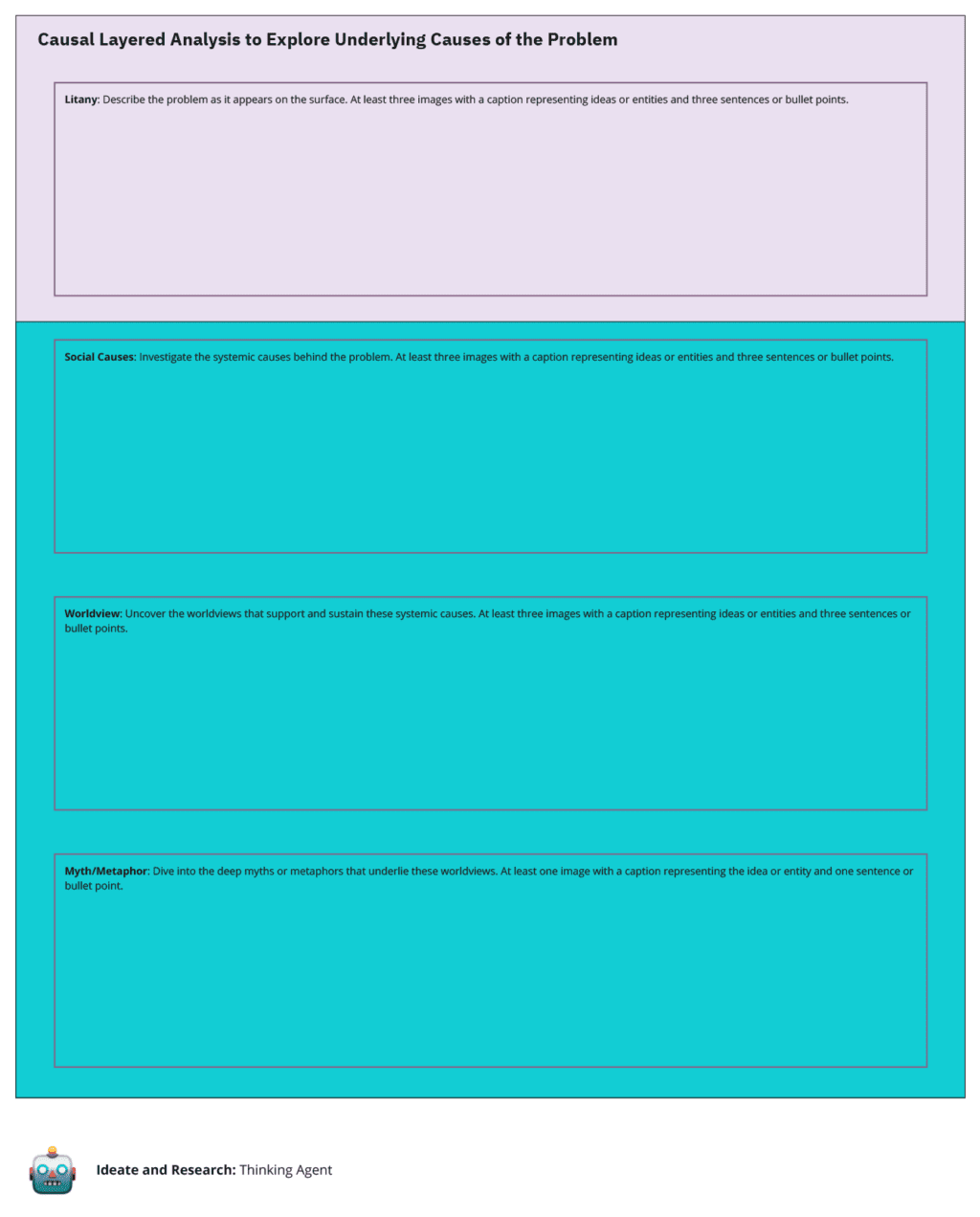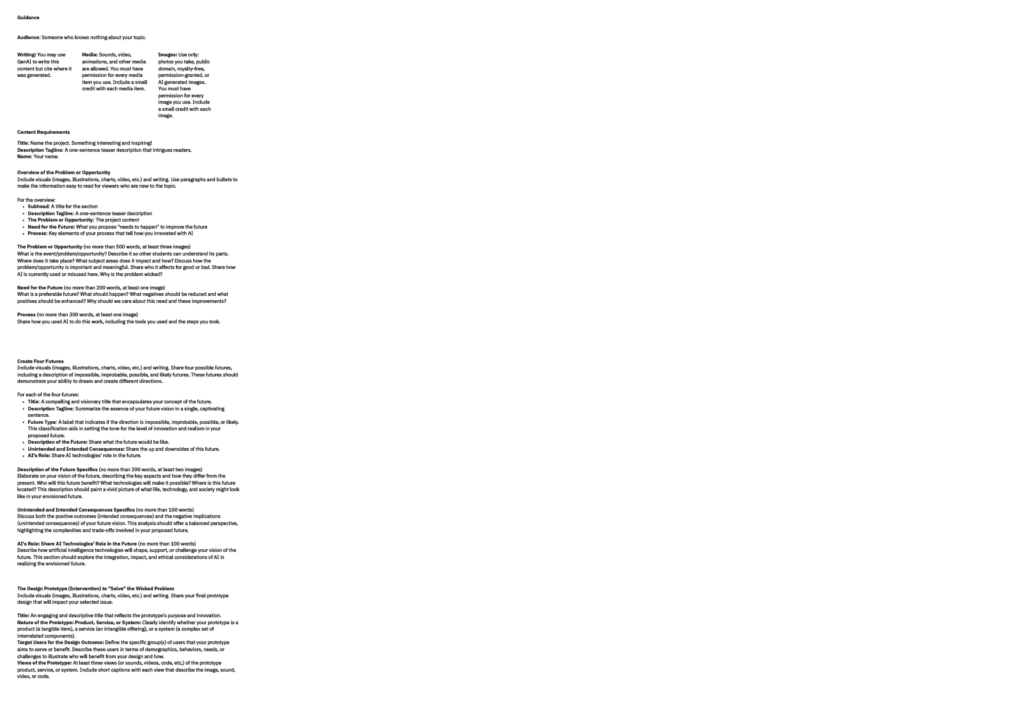Envisioning multiple futures and creating solutions to make them more likely.

The You Are The Future Project synthesizes everything we explored all semester. In this assignment, learners were invited to select a topic and then imagine and create possible futures related to that topic. Students selected everything from creating new football teams to wealth inequality to inventing a video game.
Here’s the assignment sheet from the Canvas course.
Let’s Put It All Together and Create Diverse Futures
What are you dealing with, and how can Generative AI help? Is there an issue that’s plaguing you daily? Or maybe a social issue or struggle has blocked your or someone else’s ability to function to their greatest potential. Perhaps you wish you could be more creative. Or perhaps planning meals is a chore. Maybe mental health and well-being are out of reach, and you’re seeing a way to sustain positive energy and hope. Whatever it is, this project asks you to select a topic in your sphere of influence and then use all of the methods and tools we’ve learned this semester to create a solution. Let’s make the future—a better one for us all.
What’s Due?
| What | Format | Where | Who |
|---|---|---|---|
| One You Are The Future Poster | Miro | You Are The Future S24 Miro Board. Post a comment to this Canvas assignment page to complete the turn-in. | Everyone |
Why Are We Doing This?
Your ability to envision drastically different futures in which AI technologies directly assist humans will build your imagination muscles and enhance your ability to anticipate intended and unintended consequences when AI technologies are integrated into human activities.
Specifications
This activity counts as a Project Work assignment. Work it.
Learning Outcomes
Strive to produce work that is Successful for each learning outcome.
- Align AI Outcomes With Stakeholder Needs: Use generative AI tools to create outcomes that match stakeholder needs.
- Anticipate AI Consequences: Analyze AI’s intended and unintended consequences at varying scopes.
- Create Detailed AI Outcomes: Create outcomes with generative AI tools with a high degree of formal and functional detail.
- Identify Assumptions in Wicked Problems: Identify assumptions that underlie wicked problems.
- Use AI Ethically: Demonstrate ethical use of generative AI tools.
This assignment will be complete and count toward your final grade if the work accomplishes all learning outcomes. There is no partial credit.
Parameters
Select a “wicked” or socially derived problem. Use what we learned about Wicked Problems to guide your selection criteria. Generative AI will help you along the way. After completing a design process from problem definition to solution development and testing, students will create a poster in Miro to report their work.
Use the You Are The Future Project Process Starter and the You Are The Future Poster Content Starter in this project’s Miro Board. The starters contain all the requirements.
Here’s a brief overview of what’s on the Miro Board.
You Are The Future Process
Complete this process
Setting the Scene
Choose a topic for the project and research its parts.
- Select an “undesirable present condition” (problem or opportunity) you wish to address.
- Frame the problem’s stakeholders, location, and the goal for the project,
- Define an opportunity inspired by the current event. This problem/opportunity will be the heart of the project. All work will be dedicated to solving the problem or creating products, services, or systems that enhance opportunities for those affected. Use generative AI to assist with ideation and reframing your ideas.
- Research the opportunity’s context, background, people, design, and other aspects. Work at the systems level. Identify AIs’ and peoples’ roles and how they relate to the opportunity. During this step, learn all you can about the opportunity, so you have building blocks to work with when designing solutions. Use generative AI to assist your research process.
- Define the subject areas related to the opportunity. Include your team members’ areas of study in this list.
Analyze the Opportunity and Decide on a Direction
Break the topic down into parts using various techniques supported by generative AI.
- Use various analysis techniques to dissect the problem/opportunity. For example, Soft Systems Methodology, Wicked Problems, Disruptive Hypotheses, Causal Layered Analysis, SWOT Analysis, NoSCoW Prioritization, and Cynefin Framework.
- Decide on an opportunity/need/problem to use for the project.
Create Futures
Create products, services, and systems integrating AI technologies to make two possible futures possible that “solve” the problem or enhance the opportunity.
- Complete a process for creating at least four solution directions for the opportunity: impossible, improbable, possible, and probable. For each, identify intended and unintended consequences. Use generative AI to ideate.
- Select two solution directions. Create two alternate realities that result from these selections.
- Create products, services, and/or systems for each alternate reality. Use generative AI to create prototypes.
- Test and analyze these products, services, and systems using Generative AI.
You Are The Future Poster Report
Create a poster in Miro that reports the project. Follow these parameters for the poster.
Poster Creation Guidance
- Audience: Someone who knows nothing about your topic.
- Writing: You may use benAI to write this content, but cite where it was generated.
- Media: Sounds, videos, animations, and other media are allowed. You must have permission to use every media item you use. Include a small credit with each media item.
- Images: Use only photos you take, public domain, royalty-free, permission-granted, or AI-generated images. You must have permission to use every image you use. Include a small credit with each image.
Content Requirements
- Title: Name the project. Something interesting!
- Description Tagline: A one-sentence teaser description.
- Team: The names of your team members.
Overview of the Problem or Opportunity
Include visuals (images, illustrations, charts, video, etc.) and writing. Use paragraphs and bullet points to make the information easy to read for viewers who are new to the topic.
For the overview:
- Subhead: A title for the section
- Description Tagline: A one-sentence teaser description
- The Problem or Opportunity: The project content
- Need for the Future: What you propose “needs to happen” to improve the future
- Process: Key elements of your process that tell how you innovated with AI
The Problem or Opportunity (no more than 500 words, at least three images)
What is the event/problem/opportunity? Describe it so other students can understand its parts. Where does it take place? What subject areas does it impact and how? Discuss how the problem/opportunity is important and meaningful. Share who it affects, for good or bad. Share how AI is currently used or misused here. Why is the problem wicked?
Need for the Future (no more than 200 words, at least one image)
What is a preferable future? What should happen? What negatives should be reduced, and what positives should be enhanced? Why should we care about this need and these improvements?
Process (no more than 300 words, at least one image)
Share how you used AI to do this work, including the tools you used and the steps you took.
Create Four Futures
Include visuals (images, illustrations, charts, video, etc.) and writing. Share four possible futures, including a description of impossible, improbable, possible, and likely futures. These futures should demonstrate your ability to dream and describe different directions.
For each of the four futures:
- Title: A compelling and visionary title that encapsulates your concept of the future.
- Description Tagline: Summarize the essence of your future vision in a single, captivating sentence.
- Future Type: A label that indicates if the direction is impossible, improbable, possible, or likely. This classification aids in setting the tone for the level of innovation and realism in your proposed future.
- Description of the Future: Share what the future would be like.
- Unintended and Intended Consequences: Share the ups and downsides of this future.
- AI’s Role: Share AI technologies’ role in the future.
Description of the Future Specifics (no more than 200 words, at least two images)
Elaborate on your vision of the future, describing the key aspects and how they differ from the present. Who will this future benefit? What technologies will make it possible? Where is this future located? This description should paint a vivid picture of what life, technology, and society might look like in your envisioned future.
Unintended and Intended Consequences Specifics (no more than 100 words)
Discuss both the positive outcomes (intended consequences) and the negative implications (unintended consequences) of your future vision. This analysis should offer a balanced perspective, highlighting the complexities and trade-offs involved in your proposed future.
AI’s Role: Share AI Technologies’ Role in the Future (no more than 100 words)
Describe how artificial intelligence technologies will shape, support, or challenge your vision of the future. This section should explore the integration, impact, and ethical considerations of AI in realizing the envisioned future.
The Design Prototype (Intervention) to “Solve” the Wicked Problem
Include visuals (images, illustrations, charts, video, etc.) and writing. Share your final prototype design that will impact your selected issue.
- Title: An engaging and descriptive title that reflects the prototype’s purpose and innovation.
- Nature of the Prototype: Product, Service, or System: Identify whether your prototype is a product (a tangible item), a service (an intangible offering), or a system (a complex set of interrelated components).
- Target Users for the Design Outcome: Define the specific group(s) of users that your prototype aims to serve or benefit. Describe these users in terms of demographics, behaviors, needs, or challenges to illustrate who will benefit from your design and how.
- Views of the Prototype: Include at least three views (or sounds, videos, code, etc.) of the prototype product, service, or system. Include short captions with each view that describe the image, sound, video, or code.
For Miro Board work: Post a comment in this Canvas assignment that the work is ready and turned in on time. Thanks! 👌
Execution Level
Shoot for completing this work at or beyond the level indicated below.

Review Copy: This document contains all relevant content to assert its claims so that initiated readers can understand its intent. The content is thorough enough for a reviewer to assess its claims’ validity and what revisions to make next.
Details about execution levels are in the Course Reference module.
Feedback and Revisions
Feedback
Work can receive one of the following feedback results per learning outcome (specification):
- Success: You’re done! The work meets or exceeds the specifications. Wow, you learned a lot. 🙌
- Not done yet: Close, but needs revision. The work doesn’t quite meet the goal for this assignment. Give it another go. 💪
- Incomplete: Hmm. Something’s missing. Check the specifications to find what was missed. 🤏
Work that meets all the specifications listed on this assignment page will count toward semester completions for the grade track you’re pursuing.
Revisions
You can revise the work unlimited times to achieve a “Successful” result. Revisions are due by the Final Revision Date around week 13 or 14 of the semester. Check Canvas for the exact date. Keep going! You can do this.
Tokens
You can spend a token to turn this work in late with no penalty. Enter your request to spend a token in the Comments text field in the Canvas assignment anytime, even after the due date. This assignment and all revisions are still due before the Final Revision Deadline. All group members must use a token for group projects.
Earn an Experience Booster
An Experience Booster can be added to this assignment. Adventure is out there!
You can complete an Experience Booster assignment by plussing this assignment—doing the assignment in a way you have never tried before. Before starting your work, consider how it can help you experience new things.
- People: How can you engage with diverse and unique people groups during this assignment?
- Activities: What new activities can you try because of this assignment?
- Places: What new places (real or virtual) will this assignment take you?
When the assignment starts, complete an Experience Booster Plan to get feedback on whether the project could earn an Experience Booster completion. Once the assignment is done, share what you did and earn an Experience Booster.
Each team member will complete an experience booster plan.
Complete the Experience Booster Plan: Project: You Are the Future
Process
- Complete the steps listed above.
- Turn work in as indicated on this page.
- Miro Board Work: Post a comment to this Canvas assignment page that your work was turned in.
- Check feedback in Canvas and directly in other documents (if we used Miro, Google Docs, Figma, etc.).
- Make revisions if needed.
- Post a comment to this Canvas assignment page that your revision is ready for review so I will know it’s ready.
- Learn, grow, and be amazing—because you are, no matter how you feel today.
Technology and Materials
- Internet access
Miro Poster Instructions
I posted the following instructions on our Miro whiteboard to guide poster creation.
Guidance
- Audience: Someone who knows nothing about your topic.
- Writing: You may use GenAI to write this content, but cite where it was generated.
- Media: Sounds, videos, animations, and other media are allowed. You must have permission to use every media item you use. Include a small credit with each media item.
- Images: Use only photos you take, public domain, royalty-free, permission-granted, or AI-generated images. You must have permission to use every image you use. Include a small credit with each image.
Content Requirements
- Title: Name the project. Something interesting and inspiring!
- Description Tagline: A one-sentence teaser description that intrigues readers.
- Name: Your name.
Overview of the Problem or Opportunity
Include visuals (images, illustrations, charts, video, etc.) and writing. Use paragraphs and bullet points to make the information easy to read for viewers who are new to the topic.
For the overview:
- Subhead: A title for the section
- Description Tagline: A one-sentence teaser description
- The Problem or Opportunity: The project content
- Need for the Future: What you propose “needs to happen” to improve the future
- Process: Key elements of your process that tell how you innovated with AI
The Problem or Opportunity (no more than 500 words, at least three images)
What is the event/problem/opportunity? Describe it so other students can understand its parts. Where does it take place? What subject areas does it impact, and how? Discuss how the problem/opportunity is important and meaningful. Share who it affects, for good or bad. Share how AI is currently used or misused here. Why is the problem wicked?
Need for the Future (no more than 200 words, at least one image)
What is a preferable future? What should happen? What negatives should be reduced, and what positives should be enhanced? Why should we care about this need and these improvements?
Process (no more than 300 words, at least one image)
Share how you used AI to do this work, including the tools you used and the steps you took.
Create Four Futures
Include visuals (images, illustrations, charts, video, etc.) and writing. Share four possible futures, including a description of impossible, improbable, possible, and likely futures. These futures should demonstrate your ability to dream and create different directions.
For each of the four futures:
- Title: A compelling and visionary title that encapsulates your concept of the future.
- Description Tagline: Summarize the essence of your future vision in a single, captivating sentence.
- Future Type: A label that indicates if the direction is impossible, improbable, possible, or likely. This classification aids in setting the tone for the level of innovation and realism in your proposed future.
- Description of the Future: Share what the future would be like.
- Unintended and Intended Consequences: Share the ups and downsides of this future.
- AI’s Role: Share AI technologies’ role in the future.
Description of the Future Specifics (no more than 200 words, at least two images)
Elaborate on your vision of the future, describing the key aspects and how they differ from the present. Who will this future benefit? What technologies will make it possible? Where is this future located? This description should paint a vivid picture of what life, technology, and society might look like in your envisioned future.
Unintended and Intended Consequences Specifics (no more than 100 words)
Discuss your future vision’s positive outcomes (intended consequences) and the negative implications (unintended consequences). This analysis should offer a balanced perspective, highlighting the complexities and trade-offs involved in your proposed future.
AI’s Role: Share AI Technologies’ Role in the Future (no more than 100 words)
Describe how artificial intelligence technologies will shape, support, or challenge your vision of the future. This section should explore AI’s integration, impact, and ethical considerations in realizing the envisioned future.
Miro Board Resources
Process Board: The process board below guided learners’ thinking and creation. We used it in class discussions, and each student completed a process board.

Download a PDF of the full process starter below.
A few close-ups from the process board (below).
Defining the Parts of the Problem
Learners used Experience Design Factor Blocks to inspect parts of their selected problem.

Testing the Wicked Problem
Learners used this panel to test their selected problem to ensure it was “wicked.”

Using Causal Layered Analysis to Discover Underlying Problem Components
Learners used this panel (the same one we used earlier in the course) to dissect their selected problem.

Poster Starter: Students used this poster starter with built-in instructions to create their poster “reports.”

Yes, it’s plain, but that’s the point. Learners applied critical thinking and creativity to share their visions of futures, including AI. Download a PDF of the starter below.